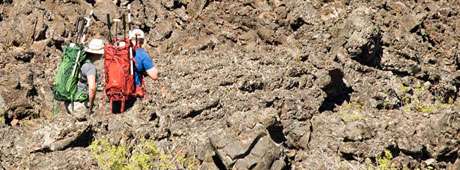No products in the cart.
Mars on Earth

Otherworldly Science in Idaho
By Faith Rudebusch
When I first explored Craters of the Moon National Monument, tagging along on a friend’s botany research trip in 2008, I marveled at the impossible terrain, which seemed as alien as Mars. Ancient lava flows unfurled as far as we could see, rippling in smooth concentric circles or breaking into craggy rifts. What should have been a mile, according to the map, stretched for hours as we carefully balanced on jagged ridges, detouring around crevices a little too wide to jump across and deep enough to swallow us whole.
I’m not the first to identify the otherworldliness of this aptly-named monument. Apollo 14 astronauts studied its geology in 1969 prior to collecting rocks from the Moon. But these basaltic rocks are a closer match to Mars than to our own moon, and they’ve been extensively studied to further our understanding of the Red Planet. Now, NASA’s goal is to send humans to Mars by the 2030s, and this bizarre landscape has become the organization’s training grounds.
I was fascinated to learn about the work of one multidisciplinary team that simulated a mission to Mars here during the summers of 2015 and 2016. For this project, called BASALT (Biologic Analog Simulation Associated with Lava Terrains), pairs of researchers standing in for astronauts, complete with high-tech backpacks and cutting-edge gear, ventured onto the lava flows on foot. They collected data and rocks, searching for conditions that could grow microbial life. Other project members supported the astronauts from inside a mission control center that in a real expedition would be on Mars, while a science team advised the proceedings from Earth (the nearby town of Arco).
This content is available for purchase. Please select from available options.
Purchase Only
Purchase Only

